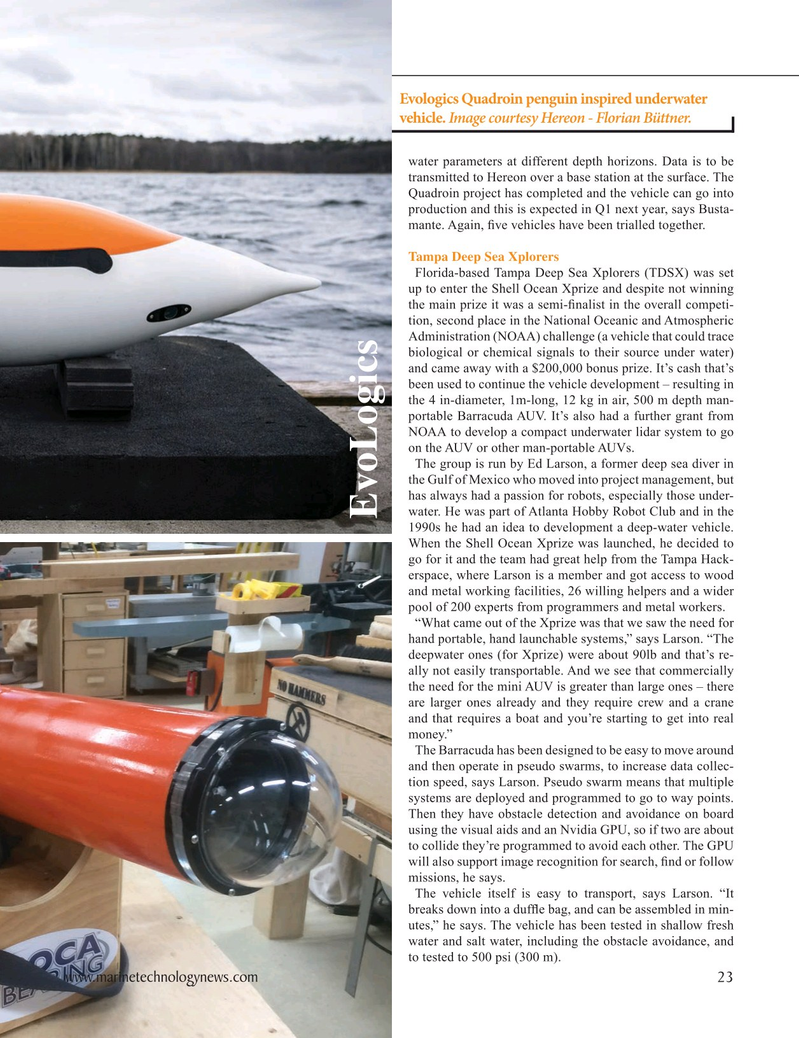
Page 23: of Marine Technology Magazine (September 2021)
MTR100: Focus on 100 Leading Companies, People and Innovations in the Subsea Space
Read this page in Pdf, Flash or Html5 edition of September 2021 Marine Technology Magazine
Evologics Quadroin penguin inspired underwater vehicle. Image courtesy Hereon - Florian Büttner.
water parameters at different depth horizons. Data is to be transmitted to Hereon over a base station at the surface. The
Quadroin project has completed and the vehicle can go into production and this is expected in Q1 next year, says Busta- mante. Again, ? ve vehicles have been trialled together.
Tampa Deep Sea Xplorers
Florida-based Tampa Deep Sea Xplorers (TDSX) was set up to enter the Shell Ocean Xprize and despite not winning the main prize it was a semi-? nalist in the overall competi- tion, second place in the National Oceanic and Atmospheric
Administration (NOAA) challenge (a vehicle that could trace biological or chemical signals to their source under water) and came away with a $200,000 bonus prize. It’s cash that’s been used to continue the vehicle development – resulting in the 4 in-diameter, 1m-long, 12 kg in air, 500 m depth man- portable Barracuda AUV. It’s also had a further grant from
NOAA to develop a compact underwater lidar system to go on the AUV or other man-portable AUVs.
The group is run by Ed Larson, a former deep sea diver in the Gulf of Mexico who moved into project management, but has always had a passion for robots, especially those under- water. He was part of Atlanta Hobby Robot Club and in the
EvoLogics 1990s he had an idea to development a deep-water vehicle.
When the Shell Ocean Xprize was launched, he decided to go for it and the team had great help from the Tampa Hack- erspace, where Larson is a member and got access to wood and metal working facilities, 26 willing helpers and a wider pool of 200 experts from programmers and metal workers. “What came out of the Xprize was that we saw the need for hand portable, hand launchable systems,” says Larson. “The deepwater ones (for Xprize) were about 90lb and that’s re- ally not easily transportable. And we see that commercially the need for the mini AUV is greater than large ones – there are larger ones already and they require crew and a crane and that requires a boat and you’re starting to get into real money.”
The Barracuda has been designed to be easy to move around and then operate in pseudo swarms, to increase data collec- tion speed, says Larson. Pseudo swarm means that multiple systems are deployed and programmed to go to way points.
Then they have obstacle detection and avoidance on board using the visual aids and an Nvidia GPU, so if two are about to collide they’re programmed to avoid each other. The GPU will also support image recognition for search, ? nd or follow missions, he says.
The vehicle itself is easy to transport, says Larson. “It breaks down into a duf? e bag, and can be assembled in min- utes,” he says. The vehicle has been tested in shallow fresh water and salt water, including the obstacle avoidance, and to tested to 500 psi (300 m). www.marinetechnologynews.com 23
MTR #7 (18-33).indd 23 9/21/2021 8:29:47 AM

 22
22

 24
24
